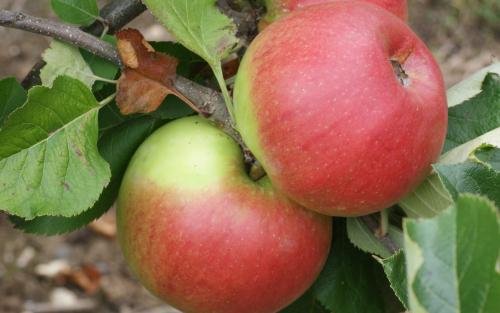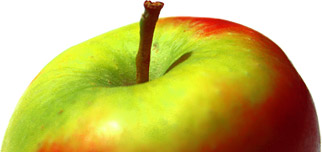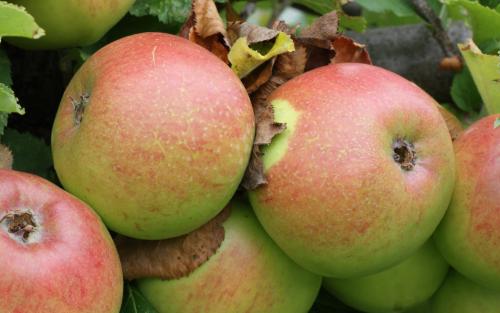
Unlike other apple-growing nations, the English have always liked to grow apple varieties specifically for culinary purposes. These "cookers" are typically large, acidic apples with good keeping qualities. Newton Wonder is typical of this style of apple - very large, with a sharp acidic flavour, which cooks down to a puree. The apples also store very well. It complements that other famous English cooker - Bramley - very well, having a slightly sweeter flavour.
The original Newton Wonder tree was found as a seedling growing out of the thatched roof of a pub in King's Newton, Derbyshire, England, in the 1870s - presumably the result of a pip dropped by a bird. It was transplanted to the garden, where the value of the large cooking apples was quickly realised. It was subsequently propagated by a local nursery, and has become a popular garden apple variety in the UK.
Newton Wonder apple identification images
All images copyright Orange Pippin unless otherwise stated.
USDA identification images for Newton Wonder
The identification paintings in the USDA Pomological Watercolor Collection span the years 1886 to 1942.
Citation: U.S. Department of Agriculture Pomological Watercolor Collection. Rare and Special Collections, National Agricultural Library, Beltsville, MD 20705.
Parents and other ancestors of this variety
- Blenheim Orange (parent)
- Dumelow's Seedling (parent)
Offspring of this variety
Visitor reviews
- 02 Oct 2024I used to eat these apples straight from the tree in my Gramothers orchard in Penshurst Kent, I was a child, the apples were as big as my head.
- 21 May 2023Grown at home on one of the larger rootstocks in permanent partial shade of a very large sycamore. Crops reliability and heavily with healthy classic cooking apples which slowly sweeten after picking and can (slight stretch) be used as an eating apple after some time (weeks in cool storage). Seems very disease resistant and has done well in a heavy clay soil. Excellent overall cooking apple.
- 12 May 2023I have seen this cultivar in the north east of Scotland
- 30 Aug 2022We had one in Duffield when we moved there in 1953 which must have been 40 years old or more as it was huge and I spent half my childhood up in the branches. Lasted another 50 years and collapsed . Excellent apples very other year.
- 30 Jun 2022My great grandad was one of the couple of men who found the seedling on the roof of the pub in King’s Newton. The seedling was then planted into the pub garden where it still stands. He didn’t actually get it off the roof, I don’t imagine, as he had a wooden leg, having lost his in a thrashing machine in his early teans. He lived in Melbourne all his life where he was a tailor, until retirement in Chellaston. He died in the very early ‘50s.
- 14 Oct 2013 ENGLAND, United KingdomWe have had an amazing crop this year, and have been eating straight from the tree since mid/late September. They are exceptional by all accounts. Looking forward to storing them and seeing how they develop in taste over the coming months.
- 01 Sep 2013 WEST YORKS, United KingdomHave a tree approx 30 years old, still crops reliably and the apples also keep really well, until March at least.
- 21 Jul 2013 DERBYSHIRE, United KingdomI have two Newton Wonders,but only recently planted.The first planted about 4 years ago. 2011 produced an excellent crop and very tasty.Very poor crop last year. The second tree planted last year and this years crop looks good.
- 22 Mar 2012 NOTTINGHAMSHIRE, United KingdomThe Newton Wonder was 'found' as a seedling on the edge of the roof of the Hardings Arms, public house, at Kings Newton in Derbyshire and was grown on to become a tree. The man responsible was Mr Taylor; my great great grandfather. The Taylors went on to become market gardeners in Stanton by bridge, not too far away; where my great grandad had an orchard in a stone masons quarry. and raised his children.
- 17 Dec 2010 WORCS, United KingdomMy family held a Glos CC small holding from 1945 until 1985,and we had a mixed orchard of apple and pear trees. The apples were about 50/50 Newtons and Bramleys, with ONE Blenheim. Mum stored them all, after their careful picking. She kept them, well strawed, on the floor of our attic. Picking them over regularly to weed out bad ones, of which there were not that many. The Newtons kept until Christmas, by which time they were matured and wonderful to eat. Still pretty crisp, but with that softer texture that comes with keeping them. My brother and I, now 75 and 70, respectively always new we'd have a good Newton in the toes of our Christmas stockings. Incidentally the pears were Williams and Conference. The Williams kept well too, and were also better, I feel, by the time Christmas came round. However, having passed the old orchard of late, the Newtons need a good pruning and a little TLC. Shame!
- 10 Oct 2010 SUFFOLK, United KingdomI have a very old Newton Wonder apple tree in my garden and the fruit really is amazing. I have to agree with the fact that it is delicious to eat and wonderful to cook with. The amount of fruit that is produced every year is astounding. . a really worthwhile apple tree
- 29 Nov 2009 BERKSHIRE, United KingdomBeautiful Apple, I have one planted in the late 1850's. Orchards were here well before the victorians put up our homes (victorian villa's). So I know it is that age. Knocks a bramley into a cocked hat. Mine has different coloured friuts and slightly different bloom and textured. The colour on one bow is a deep blood red ! Very juicy and crisp when picked, good keeper, and sweet when stored - totally unlike a bitter green and boring bramley bought in a supermarket ! The trunk is huge and hollow, with some port holes. A mini twister has recently damaged the tree very badly, the climate has changed here, the tree had been an old girl 40 years ago, but in the last 5 years the weird winds have damaged more than 40% of the tree. The tree use to throw a huge crop every other year, and 5% crop in between. The best bows have been bought down by the wind when bald and not carrying any weight.. Do not cut large branches off near the trunk, this varienty hates having its limbs cut, and dies back to a port hole eventually when it is unable to push sap to subsidiary branches. Wonderfull flavour - you cant buy this kind of quality, apple vary in size and are round, not flat like a bramley. The king apple on a spur can be huge if thinning is done
- 25 Oct 2009 GLOUCESTERSHIRE, United KingdomWe have a small orchard, planted with Bramleys newton Wonder, Cox, Blenheim and Worcesters. the newton Wonder are the best for juicing and make delicious juice and lots of it. I agree this is a better apple than a Bramley
- 11 Oct 2009 DERBY, United KingdomIm sorry Sue, but it was found , not produced in King`s Newton, Melbourne, Derbyshire. The orginal seedling is still in the garden where it was found which is now a pub beer garden. This has been well documented in the Derby Evening Telegraph.
- 03 Sep 2009 NR SWINDON, United KingdomMine is 35 yrs old and has regular heavy crops. They keep well into the new year. Very vigorous grower and not for the smaller garden.
- 29 Aug 2009 LEICESTERSHIRE, United KingdomAs I understand it my gt gt uncle, Newton Fowkes, (c1853) was responsible for producing the Newton Wonder. He had a smallholding at Swannington and Orchard in Bakewells Lane. He was also a local preacher.
- 20 Nov 2008 LUTON, BEDFORDSHIRE, United KingdomMy friend has a Newton Wonder in her garden dating back to the 1930's. They are a lovely apple and what a crop she has had this year, fantastic.
- 19 Nov 2008 DERBY, United KingdomJust to inform ... The Newton Wonder was discovered in a garden at King`s Newton, Melbourne, Derbyshire
- 27 Oct 2008 STAMFORD, United StatesHi eddie I think your apple could be a Yarling Mills and that would be a Cider apple.
- 22 Oct 2008 LONGPARISH HAMPSHIRE, United KingdomI have just discovered that the "unknown" apple tree in our garden is a Newton Wonder, and I have to agree with Edward Buckle- this is a dual purpose apple. We've had it picked straight off the tree as a crisp and sweet eater, as well as a fabulous cooker. We have Bramleys Seedlings too, and in my book the Newton Wonder is better. This year's crop was astoundingly large and heavy individual apples, and lots of them- our best crop in fifteen years.
- 17 Oct 2008 HALESWORTH SUFFOLK UK, United KingdomFabulous prolific apple - more a cooker/eater than a straight cooker as I eat them every day from the tree until they're gone - last well in cool store if they survive my appetite. In passing do you know the apple Yarling as i was given one and I can't find the history or any acknowledgement - small conical apple with pale pink blush - taste OK but texture mealy - but my plant young may improve with age or in a better season - thanks Yours Eddie Buckle
Tree register
United States
- e Mcclelland in OXFORD,
United Kingdom
- Adam Norman in Tadcaster, ENGLAND
- Andrew Guille in St Saviour, GUERNSEY
- Andrew Shields in Alnwick, NORTHUMBERLAND
- Babs Powell in Stonehouse, GLOUCESTERSHIRE
- Bill Potter in Crosby, Maryport, CUMBRIA
- Billy Auger in HOPTON WAFERS, SHROPSHIRE
- Carol in Lincoln, LINCS
- Celia Cropper in Manchester, LANCASHIRE
- Chaughton in Tiverton, DEVON
- Cindy Reynolds in Aldershot, HAMPSHIRE
- David Proe in Bristol, SOUTH GLOUCESTERSHIRE
- David Proe in Bristol, SOUTH GLOUCESTERSHIRE
- Denise Casanova in Mildenhall, SUFFOLK
- Derek Whitmell in Upton, Didcot, OXON.
- Dick Burnham in Whittlesey, PETERBOROUGH
- Elizabeth Hodge in Evesham, WORCESTERSHIRE
- Finlay Maciver in Hull, EAST YORKS
- Freyja Burrill in Kings Meaburn/ Penrith, CUMBRIA
- Graeme Stockdale in Pilsley, Chesterfield, DERBYSHIRE
- Graham Hinchliffe in Eastbourne, EAST SUSSEX
- Harry Millward-Sadler in Crossbush Nr Arundel, WEST SUSSEX
- Henryc in Andover, HAMPSHIRE
- Hugh Morton in Kingsbridge,
- Huw in Stamford, LINCS
- James in Melbourne, DERBYSHIRE
- Janet Coley in Bicester, OXFORDSHIRE
- Jean Lippett in Martock, SOMERSET
- Jon in Brigg, LINCOLNSHIRE
- Jordan Noble in Notts, UK
- Jsansell@Hotmail.Com in Chalford, UNITED KINGDOM
- Kate Bagenal-Lowe in Wooler, NORTHUMBERLAND
- Kathy Doyle in Swindon, WILTSHIRE
- Kevinincornwall in Liskeard, UNITED KINGDOM
- Lee Smeaton in Holbeach, LINCOLNSHIRE
- Margaret Brooker in Ellerker, EAST YORKSHIRE
- Mark Davies in Saddleworth, YORKSHIRE
- Melanie Fuller in Harrogate, NORTH YORKSHIRE
- Melanie Fuller in Harrogate, NORTH YORKSHIRE
- Nia Lock in Bollington, CHESHIRE
- Nick Burrows in Helmsley, NORTH YORKSHIRE
- Paul Haines in Llandyfriog, Newcastle Emlyn, CEREDIGION
- Paul Mckean in Southport, MERSEYSIDE
- Peter Hicks in Exeter, DEVON
- Peter Samsom in Hexham, NORTHUMBERLAND
- Robert@Ankeow.Freeserve.Co.Uk in Newquay, CORNWALL
- Roger Drage in Burton Latimer, NORTHAMPTONSHIRE
- Roger Drage in Burton Latimer, NORTHAMPTONSHIRE
- Rosie Jones in Ystrad Meurig, CEREDIGION
- Samantha Cribben in Eye, SUFFOLK
- Steve Webster in Truro, CORNWALL
- Steve Webster in Truro, CORNWALL
- Stuart Currie in Havant, HAMPSHIRE
- Sue Fawcett in Pocklington, York, YORKSHIRE
- Suzanne Mcnally in Banbury, OXON
- Victor Carter, Aae Fimi in Huddersfield, WEST YORKSHIRE
- Warren Glendinning in London, MIDDLESEX UK
Spring blossom records for this variety
2022 season
- 9th May 2022 - tree owned by Hugh in Kingsbridge, United Kingdom
2017 season
- 13th May 2017 - tree owned by Hugh in Kingsbridge, United Kingdom
- May 2017 - tree owned by Andrew in Alnwick, United Kingdom
2013 season
- 31st May 2013 - tree owned by Andrew in St Saviour, United Kingdom
- 18th April 2013 - tree owned by Chaughton in Tiverton, United Kingdom
2012 season
- 27th May 2012 - tree owned by Andrew in St Saviour, United Kingdom
- May 2012 - tree owned by Victor in Huddersfield, United Kingdom
2011 season
- 26th April 2011 - tree owned by James in Melbourne, United Kingdom
- 23rd April 2011 - tree owned by Roger in Burton Latimer, United Kingdom
- 22nd April 2011 - tree owned by Roger in Burton Latimer, United Kingdom
- March 2011 - tree owned by Warren in London, United Kingdom
2010 season
- 18th May 2010 - tree owned by Roger in Burton Latimer, United Kingdom
- 14th May 2010 - tree owned by Roger in Burton Latimer, United Kingdom
- 20th April 2010 - tree owned by Jordan in Notts, United Kingdom
Record your blossom dates in our Fruit Tree Register - more >>.
Harvest records for this variety
2017 season
- October 2017 - tree owned by Andrew in Alnwick, United Kingdom
2016 season
- 2nd week November 2016 - tree owned by Hugh in Kingsbridge, United Kingdom
- 2nd week October 2016 - tree owned by Jsansell@Hotmail.Com in Chalford, United Kingdom
2015 season
- 2nd week October 2015 - tree owned by Peter in Hexham, United Kingdom
2014 season
- 1st week October 2014 - tree owned by Dick in Whittlesey, United Kingdom
2013 season
- 1st week October 2013 - tree owned by Chaughton in Tiverton, United Kingdom
2012 season
- 3rd week October 2012 - tree owned by Victor in Huddersfield, United Kingdom
2011 season
- 3rd week October 2011 - tree owned by Huw in Stamford, United Kingdom
- 2nd week October 2011 - tree owned by Victor in Huddersfield, United Kingdom
- October 2011 - tree owned by Warren in London, United Kingdom
2010 season
Origins
- Species: Malus domestica - Apple
- Parentage: Possibly Dumelow's Seedling and Blenheim Orange
- Originates from: Derby, England, United Kingdom
- Introduced: 1870s
- Developed by: Found by an innkeeper, Mr Taylor
- UK National Fruit Collection accession: 1973-140
- Some historical details taken with kind permission from 'The New Book of Apples' by Joan Morgan and Alison Richards , illustrated by Elisabeth Dowle, published by Ebury Press, 2002.
Identification
- Country of origin: United Kingdom
- Period of origin: 1850 - 1899
- Flower colour: White
- Leaf colour: Green
- Popularity: Best sellers
- Annual cycle: Deciduous
- Awards: RHS AGM (former)
Using
- Picking season: Late
- Keeping (of fruit): 3 months or more
- Flavour quality: Very good
- Flavour style (apples): Sharper
- Cooking result: Puree
- Discoloration of fruit: Oxidising
- Cropping: Heavy
- Fruit persistence: Normal ripening
- Food uses: Culinary
- Food uses: Traditional cooker
- Picking period: mid-October
- Wildlife: RHS Plants for Pollinators
Growing
- Gardening skill: Average
- Flowering group: 4
- Pollinating others: Average
- Ploidy: Diploid
- Vigour: Vigorous
- Bearing regularity: Biennial tendency
- Fruit bearing: Spur-bearer
- Organic culture: Suitable
- Self-fertility: Partially self-fertile
Climate
- Frost resistance of blossom: Good resistance
- Climate suitability: Temperate climates
- Climate suitability: Mild damp climates
- Summer average maximum temperatures: Cool ( 20-24C / 68-75F)
- Cold hardiness (RHS): H6 (to -20C)
- Summer average maximum temperatures: Cold (< 20C / 67F)
Other qualities
- Disease resistance: Average
- Canker: Some resistance
- Scab (Apple and Pear): Some resistance
- Powdery mildew: Some susceptibility
Where to buy trees
The following tree nurseries offer Newton Wonder apple trees for sale:
- Orange Pippin Fruit Trees (UK) United Kingdom
Newton Wonder apple trees - Keepers Nursery
United Kingdom More >>
Where to buy fresh fruit
The following orchards grow Newton Wonder:
United Kingdom
England - midlands
- Walsgrove Farm, Worcester
England - north
- Pickering Road Community Orchard, Hull
- Holly Mount Orchard, Bury
- Coulton Mill, York
England - south-east
- Kimpton Manor Apple Press, Andover
References
- Apples of England (1948)
Author: Taylor - Fruit Expert
Author: Hessayon


